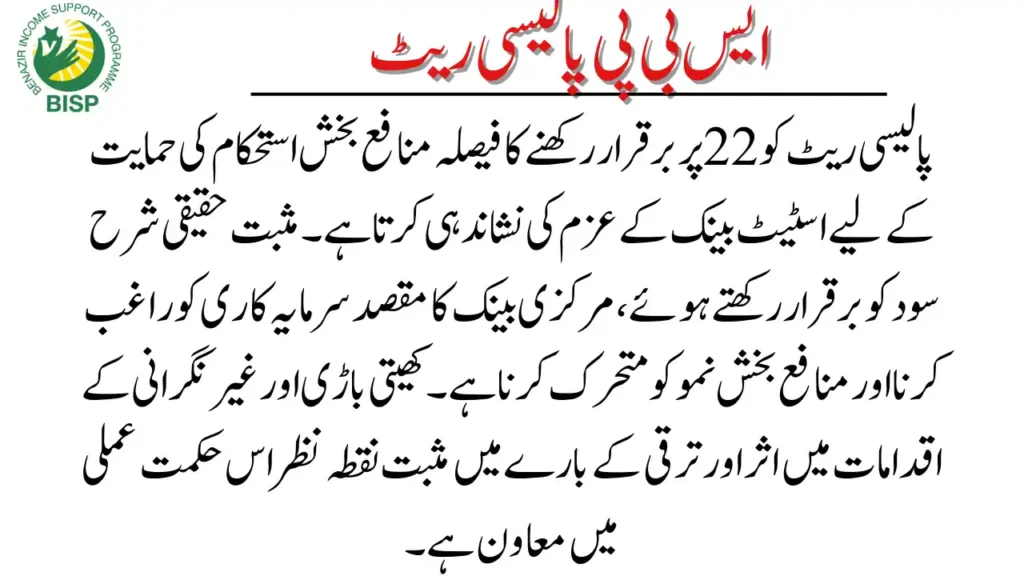SBP Policy Rate
In a surprising move, the SBP Policy Rate of Pakistan( SBP) decided to keep its standard policy rate at 22, defying prospects of an aggressive rate hike of over to 300 base points. This unanticipated decision by the Monetary Policy Committee( MPC) has transferred ripples through the fiscal requests and raised questions about the central bank’s explanation. In this composition, we’ll explore the factors behind this decision and its implicit impact on Pakistan’s frugality.
Table of Contents
SBP Decision:
The SBP Policy Rate decision to maintain the policy rate at 22 is driven by several crucial factors
1. Affectation Trends:
The central bank’s decision takes into account the rearmost affectation data, which shows a declining trend. In May 2023, affectation reached a peak of 38, but it has since dropped to 27.4 in August 2023. This downcast line in affectation has handed the SBP Policy Rate with the confidence to hold the policy rate steady.
2. Global oil painting Prices:
While global oil painting prices have been on the rise, the SBP Policy Rate believes that the impact on affectation will be limited. The statement highlights that affectation is anticipated to continue dwindling, especially in the alternate half of the time, despite the recent swell in oil painting prices.
Also Read :Dollar rate against Pakistani Rupess
3. Positive Real Interest Rates:
One critical point made by the SBP is that real interest rates, which consider affectation, remain in positive home when looking ahead. This implies that the current interest rates are anticipated to give a real return, which can attract investments and support profitable growth.
4. Supply Constraints and Academic exertion:
The enhancement in the husbandry outlook, grounded on data related to cotton advents, input conditions, and satellite data showing healthy foliage in other crops, has contributed to the positive sentiment.
Rising Global oil painting Prices:
Global oil painting prices have increased and are now approaching the$ 90 per barrel mark. While this is a concern, the SBP believes that it will not ail the declining affectation trend significantly.
Current Account deficiency:
The current account, which had been in fat for the last four months, shifted to a deficiency in July. This shift was anticipated, incompletely due to the relaxation of import restrictions. still, it’s considered a manageable development.
Regulatory Measures:
The SBP’s recent executive and nonsupervisory measures to ameliorate the vacuity of essential food goods and check illegal conditioning in the foreign exchange request have started to yield positive results. This has helped constrict the gap between the interbank and open request exchange rates, reducing exchange rate volatility.

SBP Policy Rate
Implicit Counteraccusations:
The decision to keep the policy rate unchanged at 22 suggests the SBP’s commitment to supporting profitable stability. By maintaining a positive real interest rate, the central bank aims to attract investment and stimulate profitable growth. The positive outlook on affectation and advancements in husbandry and nonsupervisory measures contribute to this strategy.
Related: How To apply Benazir Ehsaas Kafalat
State Bank of Pakistan (SBP) decision
The State Bank of Pakistan (SBP) decided to keep the policy rate unchanged at 22% on December 13, 2023. This decision was made in light of the ongoing economic challenges faced by the country, including high inflation and a widening current account deficit.
Reasons for the Unchanged Policy Rate:
- Persistent Inflation: Despite recent declines, inflation remains significantly above the SBP’s target range of 5-7%. This is primarily due to supply chain disruptions, global commodity price hikes, and the depreciation of the Pakistani rupee.
- Large Current Account Deficit: Pakistan’s current account deficit has widened to a record level, putting pressure on the rupee and foreign exchange reserves. The SBP believes that a higher policy rate will help to attract foreign investment and reduce the deficit.
- Uncertainty in Global Economy: The global economy is facing a number of headwinds, including the ongoing war in Ukraine and rising interest rates in developed countries. This uncertainty poses a risk to the Pakistani economy, and the SBP is likely to maintain a cautious stance until the situation becomes clearer.
Conclusion:
The SBP’s decision to hold the policy rate steady at 22 reflects its confidence in the declining affectation trend, positive real interest rates, and positive developments in the husbandry sector and nonsupervisory geography. While this decision aims to promote profitable stability, it also comes with implicit challenges, similar as managing the impact of rising global oil painting prices.

